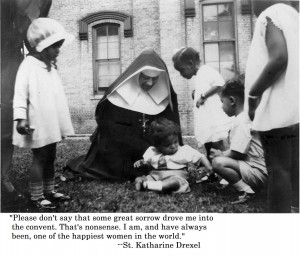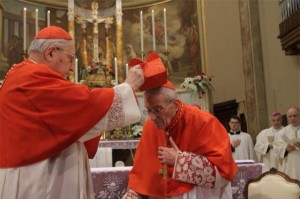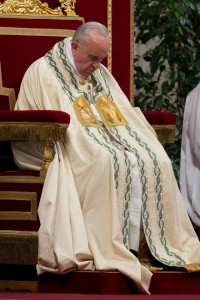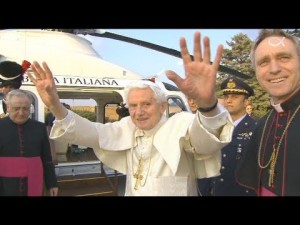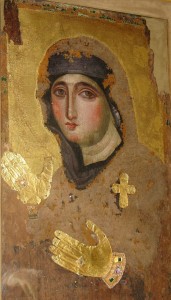 Do you ever think about our use of light in the Church? Does the use of light in the Liturgy ever cross your mind other than what you have experienced at annual the Easter Vigil? Even those churches with dedication candles rarely, if ever, get used. So, it seems fair to say that we don’t think of lighting the Church as remotely significant to the liturgical act, not at least since Thomas Edison. The use of electricity has minimized the sensual experience of light and darkness as part of the litugical-theological drama in the Latin Church, and in the Eastern Churches where it was more developed over the centuries. But the Easterns have burned through tradition.
Do you ever think about our use of light in the Church? Does the use of light in the Liturgy ever cross your mind other than what you have experienced at annual the Easter Vigil? Even those churches with dedication candles rarely, if ever, get used. So, it seems fair to say that we don’t think of lighting the Church as remotely significant to the liturgical act, not at least since Thomas Edison. The use of electricity has minimized the sensual experience of light and darkness as part of the litugical-theological drama in the Latin Church, and in the Eastern Churches where it was more developed over the centuries. But the Easterns have burned through tradition.
I have tried to get priests and altar servers to be more attentive to the use of light and shadow in the time prior to and following the Mass but efforts have been rather difficult. More often we think of convenience, that is utility, as having a higher value than biblical typology. Think of the various points found in the Pentateuch, the prophets and the gospel of John. I happen to think that we need a recovery of biblical typology influencing liturgical ritual in concrete ways. Benedict XVI taught us this fact, too. Surely you might concede that Divine Revelation and development of biblical imagery in the Liturgy of Christ the Light has much to teach us —the lex orandi, lex credendi— thus having an educative side to our Catholic worship and imagination. The worship of God educates us as well as give proper glory and honor to God.
Catholic liturgy over the years has taught us that the burning candle is a form of sacrifice, a gift consuming itself just like the fire consuming the animal sacrifice; it also serves as a reminder of the prayerful intentions of the faithful. Churches have vigil lights at shrines imploring intercession. Even more poignant is the Paschal Candle because of its symbolism of the risen Christ Jesus. Some will recall that the wax made by honey bees is said to represent the flesh of Jesus; the wick and the wax working together is understood as a symbol of the hypostatic union of the Lord’s humanity and divinity; the flame recalls the Lord’s divinity. The biblical readings and prayers prayed at the Easter Vigil will remind the faithful of God’s presence among the Israelites in a pillar of flame. And no Catholic Church with the Eucharistic Presence is left without a vigil light continuously lit indicating the presence of Jesus Christ.
Imagine what our worship of the Triune God would be like if we were slightly more attentive to revelation and biblical premise! Certainly, our Christian anthropology would be keener. Little known is the Syriac liturgical tradition of which the Maronite Church belongs, has the unique ritual in the Liturgy of Lighting the Church. Yet, the lighting ritual has not really been seen in the USA too much until recently when Maronite Bishop Gregory Mansour asked the priests of the Eparchy of St Maron to shed some good light with both the candle lighting and the preparation of the gifts using the ritual the of “Lighting of the Church.”
Chorchishop Seely Beggiani, a liturgical theologian and recently the former rector of the Maronite Seminary in Washington, wrote about Light in the ritual of the Maronites.
Light is taken for granted by most people in the twentieth century. Our modern science has demystified the sun, the cycle of the seasons and the solar year. The invention of electricity has given ordinary human creatures power over light and darkness. Earlier generations were in awe of the sun and light. When day came to a close and pitch darkness covered the earth, they prayed that the sun would rise again and that warmth and life would again deliver them from the seemingly endless cold and a dying earth. Our ancestors had a deep awareness of their total dependence on light.
However, modern science can also make us aware of the absolute necessity of light in our lives. Photosynthesis is critical to any life at all on earth. If humans were deprived absolutely of light for even a short time, they would go mad and ultimately die. It is no accident that according to Albert Einstein the speed of light is the absolute for our universe.
Our faith tradition teaches us that primordial light was the first creation of God and thus the very stuff of the universe. God is portrayed as the “Father of Lights” and Christ is the Light of the World. The Bible often teaches us that we ultimately choose to live our lives either according to the Way of Light or the Way of Darkness; and that light leads to life while darkness leads to death. The true nature of Christ was revealed as uncreated light at the transfiguration, and it was the light of Christ at his death that destroyed the darkness of Sheol (the region of the dead.) Our immortal destiny is presented as the eighth day of creation where the sun will never set, where we are called to view the shining face of Christ.
It is for all these reasons that the lighting of the Church in preparation for the divine liturgy has such a great significance. In participating in this act we are proclaiming our readiness to be children of the light and to allow our deeds to be judged in the open light of day. The lighting of the candles announces the presence of Christ, the light of the world, whom we welcome among us. In the fully lighted church which represents the universe in miniature, we give thanks for the light and warmth of God’s creation.”

